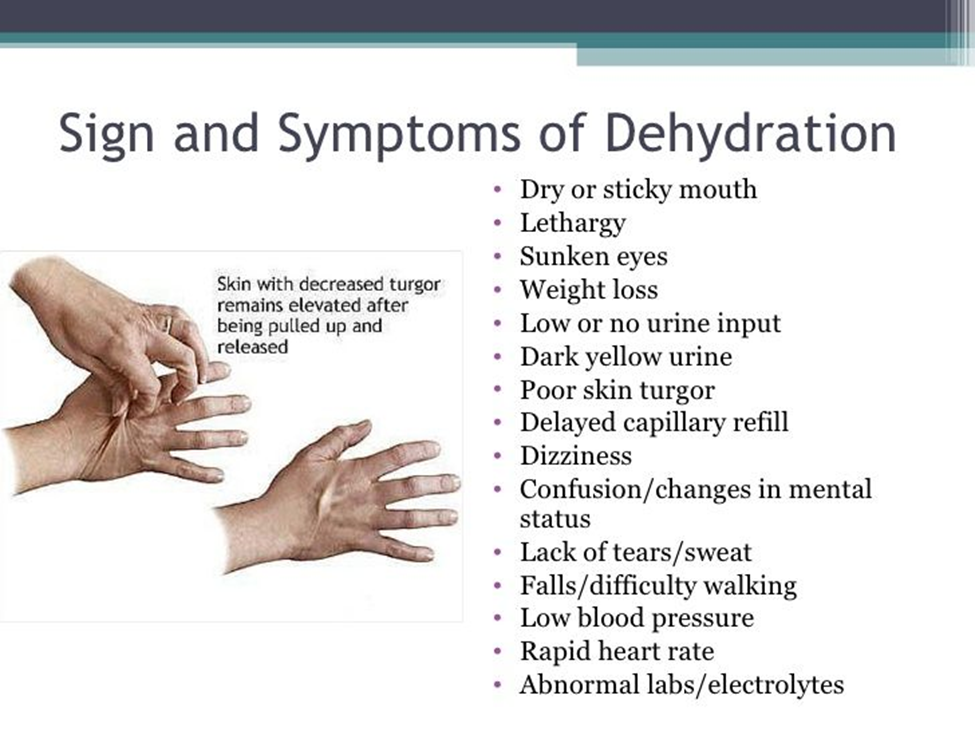A nurse in a community clinic is collecting data from an older adult client who has a body mass index of 17.5. When evaluating the client for dehydration, the nurse should look for which of the following indications of fluid-volume deficit?
Tenting
Protruding eyeballs
Elevated blood pressure
Dry mucous membranes
The Correct Answer is A
A. Tenting
Tenting refers to the delayed recoil of the skin when pinched. In a dehydrated state, the skin loses elasticity, leading to tenting due to decreased skin turgor. This is a specific sign of fluid-volume deficit.
B. Protruding eyeballs
Protruding eyeballs are not typically associated with dehydration. This could be related to other conditions such as thyroid dysfunction, but it is not a specific indicator of fluid-volume deficit.

C. Elevated blood pressure
Elevated blood pressure is not a typical sign of dehydration. In fact, dehydration often leads to a decrease in blood pressure due to reduced blood volume.
D. Dry mucous membranes
Dry mucous membranes can be an indication of dehydration, but in the context of the question, tenting (Option A) is a more specific sign related to skin turgor and is commonly assessed when evaluating for dehydration.
Nursing Test Bank
Naxlex Comprehensive Predictor Exams
Related Questions
Correct Answer is C
Explanation
A. To help the nurse validate the client’s reports of pain
This option suggests that the nurse's actions (straightening bed linens, rubbing the back, assisting with repositioning) are intended to assess or confirm the client's reports of pain. However, these actions are more aligned with providing comfort and assistance with activities of daily living rather than specifically assessing pain. If the client reports pain related to the chest tube, a more focused assessment and intervention would be needed.
B. To increase positive pressure in the chest
This option implies that the nurse's actions could somehow influence the positive pressure in the client's chest, which is not accurate. Positive pressure in the chest is usually related to mechanical ventilation or specific medical interventions. The described actions are more related to comfort and assistance with daily activities.
C. To assist the client with ADLs (Activities of Daily Living)
This is the most appropriate choice. The nurse's actions, such as straightening bed linens, rubbing the back, and assisting with repositioning, align with providing support for the client's daily activities and overall well-being.
D. To modify the client’s perception of pain
This option suggests that the nurse's actions are aimed at altering the client's perception of pain. While comfort measures can contribute to pain management, these specific actions are not typically used to modify perception. If pain is a concern, more direct pain management strategies and assessments would be appropriate.
Correct Answer is A
Explanation
A. Fiber
For a client with hypothyroidism, the nurse should reinforce the importance of increasing daily intake of fiber. Hypothyroidism can sometimes lead to constipation, and a diet rich in fiber can help alleviate this symptom.
B. Monounsaturated fats
While monounsaturated fats are considered heart-healthy and can be included in a balanced diet, they are not particularly emphasized or increased for clients with hypothyroidism.
C. Protein
Adequate protein intake is important for overall health, but there is no specific recommendation to increase protein intake solely because of hypothyroidism.
D. Polyunsaturated fats
Similar to monounsaturated fats, polyunsaturated fats are part of a healthy diet, but there is no specific emphasis on increasing their intake for clients with hypothyroidism.
Whether you are a student looking to ace your exams or a practicing nurse seeking to enhance your expertise , our nursing education contents will empower you with the confidence and competence to make a difference in the lives of patients and become a respected leader in the healthcare field.
Visit Naxlex, invest in your future and unlock endless possibilities with our unparalleled nursing education contents today
Report Wrong Answer on the Current Question
Do you disagree with the answer? If yes, what is your expected answer? Explain.
Kindly be descriptive with the issue you are facing.
